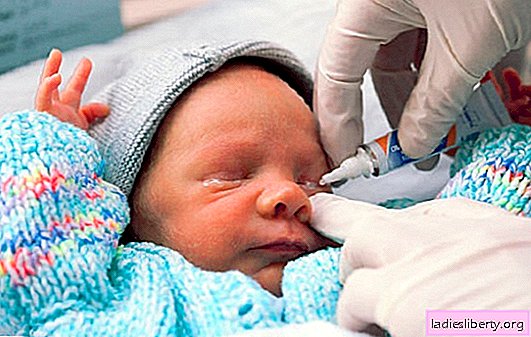
Conjunctivitis is an inflammatory process of the mucous membrane of the eyes (conjunctiva). It recalls the clinical manifestations of dacryocystitis (inflammation of the lacrimal sac) or non-opening of the lacrimal canal. The frequency of conjunctivitis in a newborn (neonatal conjunctivitis, ophthalmia of the newborn) is 1-2%, with timely medical attention and proper treatment, it passes quickly.
Conjunctivitis in a newborn - causes and transmission of the disease
The most common causes of conjunctivitis in a newborn are:
• low immunity;
• non-observance of hygiene rules.
Routes of transmission for infectious lesions:
• vertical path - when a child passes through the birth canal (bacteria, living in the mother’s body, or chlamydia or gonococcus from an infected mother get on the mucous membrane of the eye);
• contact - from a mother infected with oral or genital herpes;
• in contact with the eyes of a newborn's dirt or foreign body.
Classification of conjunctivitis
According to the etiological factor, conjunctivitis is divided into
• allergic;
• viral;
• bacterial;
• fungal (develops in children with immunodeficiency, is rare);
• autoimmune (rare in newborns).
Bacterial conjunctivitis can be caused by the following infectious agents:
• staphylococcus;
• streptococcus;
• gonococcus;
• chlamydia;
• enterobacteria.
Viral conjunctivitis is caused by infection:
• adenovirus;
• oral or genital herpes virus.
Inflammation of the eye mucosa can be caused by a microbial association: a bacterium and a virus at the same time.
Symptoms of conjunctivitis in a newborn
With conjunctivitis in a newborn, the symptoms may be similar, regardless of the etiological factor:
• hyperemia and edema of the eye mucosa;
• swelling can spread to the cheeks;
• lacrimation;
• allocation in the morning of purulent contents from the eyes (with pathology caused by bacteria);
• the formation of purulent crusts on the eyelids and eyelashes,
• the inability to open your eyes in the morning due to the stickiness of the eyelids and purulent crusts;
• photophobia;
• bad sleep;
• reduced appetite;
• may increase the temperature;
• tearfulness, anxiety of the child.
Features of the clinical manifestations of the disease of various etiologies
Depending on the pathogen, the symptoms of conjunctivitis in a newborn have their own characteristics.
1. Bacterial conjunctivitis is a purulent inflammation of the mucous membrane of the eye. It differs from a viral one-sided lesion: the inflammatory process occurs in only one eye. Thick purulent discharge occurs, but the conjunctiva and skin around the eyes are dry. The course is severe, but treatment of this particular type of ophthalmia is easier and faster than viral. The risk of complications after a disease is minimal.
2. Viral conjunctivitis affects both eyes in turn, but is easier to tolerate. Concomitant with SARS: it can occur with high fever, runny nose, sore throat. The result of treatment depends on its timely start: viruses can spread in the body and cause severe complications, affecting internal organs. Therefore, when identifying the first symptoms, treatment must be started as quickly as possible for its effectiveness.
3. Allergic conjunctivitis is characterized by a large amount of transparent excreted, accompanied by severe itching and frequent sneezing. If the allergen is removed, the disease quickly disappears.
Differential diagnosis
In the differential diagnosis of conjunctivitis, certain signs are analyzed, on the basis of which the type of disease is specified and, in accordance with it, further treatment tactics.
1. Detachable and contained cells:
• with bacterial conjunctivitis - purulent with neutrophils;
• when viral - bright with mononuclear cells;
• with allergic - light color, slime-like, viscous with a high content of eosinophils.
2. Edema of the eyelids:
• with bacterial conjunctivitis - moderate;
• with viral - minimal;
• for allergic - moderate to severe.
3. The condition of the lymph nodes: they increase with viral etiology, with other types of the disease - there are no changes.
4. Itching only bothers with allergic eye damage.
The most dangerous conjunctivitis is gonococcal.
Most often, bacterial conjunctivitis occurs. This is the most dangerous type of eye damage for the health and life of the child. Infection occurs during childbirth in a sick mother. With gonococcal conjunctivitis in a newborn, symptoms are detected already on 3 or 4 days of life:
• pronounced swelling of the eyelids of a cyanotic-crimson color;
• over time - compaction of the edema to such an extent that you cannot open your eyes;
• loosening, hyperemia and bleeding of the conjunctiva;
• spotting from an inflamed mucosa;
• reduction of edema after 3-4 days, but increased profuse discharge of purulent nature of a yellowish color.
The danger of gonococcal conjunctivitis is the spread of infection to the cornea, resulting in eye death and complete loss of vision. Since 1997, in order to prevent gonoblenorrhea in newborns, a 20% solution of sodium sulfacyl (albucide) has been instilled in all eyes in both eyes in all children. After a minute, the procedure is repeated.
Chlamydial conjunctivitis - a common lesion
Chlamydial conjunctivitis is the most common (40%) infection. Microbe transmission occurs vertically during childbirth. The risk of infection is 40 - 70%.
With chlamydial conjunctivitis in a newborn, symptoms develop 10-14 days after birth. The process is two-way, characterized by:
• acute development;
• copious purulent discharge;
• layers on the lower eyelid in the form of a gray film;
• an increase in parotid lymph nodes (rarely).
Pneumococcal conjunctivitis
In this type of infection, both eyes are affected at the same time. It manifests itself:
• severe edema of the eyelids;
• a small point rash on the mucous membrane of the eye;
• a thin gray film on the mucous membrane that is easily removable with a gauze swab (you cannot use cotton wool).
Staphylococcal eye lesion
Staphylococcal ophthalmia: pathogen - Staphylococcus aureus. It develops against a background of purulent-septic diseases:
• pyoderma (pustular rashes on the skin);
• omphalitis (purulent process in the umbilical wound).
The latent period is from 1 to 3 days. Purulent or purulent-mucous discharge accumulates in the inner corners of the eyes. Subsequently, yellowish crusts form, sticking together eyes. In rare cases, the temperature rises.
Viral infection of the eyes
With a viral etiology of inflammation, the most common causative agent is the herpes simplex virus. The transmission path is vertical. Both one and both eyes are involved in the inflammatory process. The clinical picture is characterized by plentiful watery transparent discharge;
• the formation of multiple vesicles on the mucosa;
• hemorrhages in the sclera;
• combination with intestinal dysfunction.
Adenoviral conjunctivitis in the newborn is rare. Usually accompanied by signs of this infection:
• high fever and severe signs of intoxication;
• cough, runny nose;
• lacrimation;
• photophobia;
• hyperemia and swelling of the eyelids;
• the appearance on the whites of the eyes of characteristic vesicles, hemorrhages or grayish plaque.
The virus can penetrate deep into the eye, resulting in decreased vision.
Other conjunctivitis
Allergic conjunctivitis develops in children during the flowering period of plants. Any other allergen can become a source: dust, wool, feathers. Characteristic symptoms:
• pronounced edema of the eyelids;
• lacrimation and clear discharge from the nose;
• severe itching.
Fungal conjunctivitis occurs in newborns with immunodeficiency and is manifested by white crumbling secretions. The mucous membrane of the eye becomes hyperemic and loose.
Treatment of conjunctivitis in a newborn
With conjunctivitis in a newborn, treatment should be comprehensive and begin as early as possible. In addition to the complications that may arise with untimely initiation of therapy, if the disease is caused by microorganisms, it is considered contagious and can be easily transmitted to other family members by contact. Treatment options include:
• eye wash with disinfectants to remove discharge;
• instillation of anesthetics (if corneal syndrome has developed in the form of photophobia);
• use of antibiotics.
With conjunctivitis in a newborn, treatment is selected individually depending on the type of pathology detected. Antibacterial, antiviral, desensitizing or antifungal therapy is carried out locally: eye drops, ointments or solutions are used. The frequency of application and the duration of treatment are prescribed individually. In the acute period, drops are used 6-8 times a day, gradually reducing to 3-4 times. After complete recovery for the prevention of relapse, treatment continues for another 3 days.
In order to avoid such diseases, a regular examination of the child by a pediatrician is necessary, and at the first signs of trouble, immediately seek medical help and do not self-medicate.











